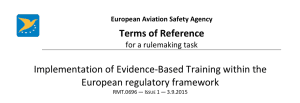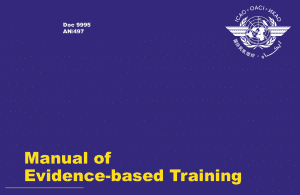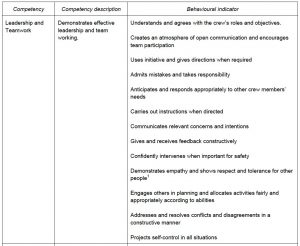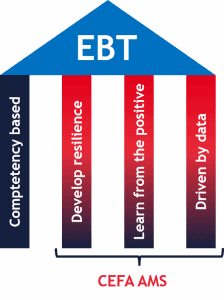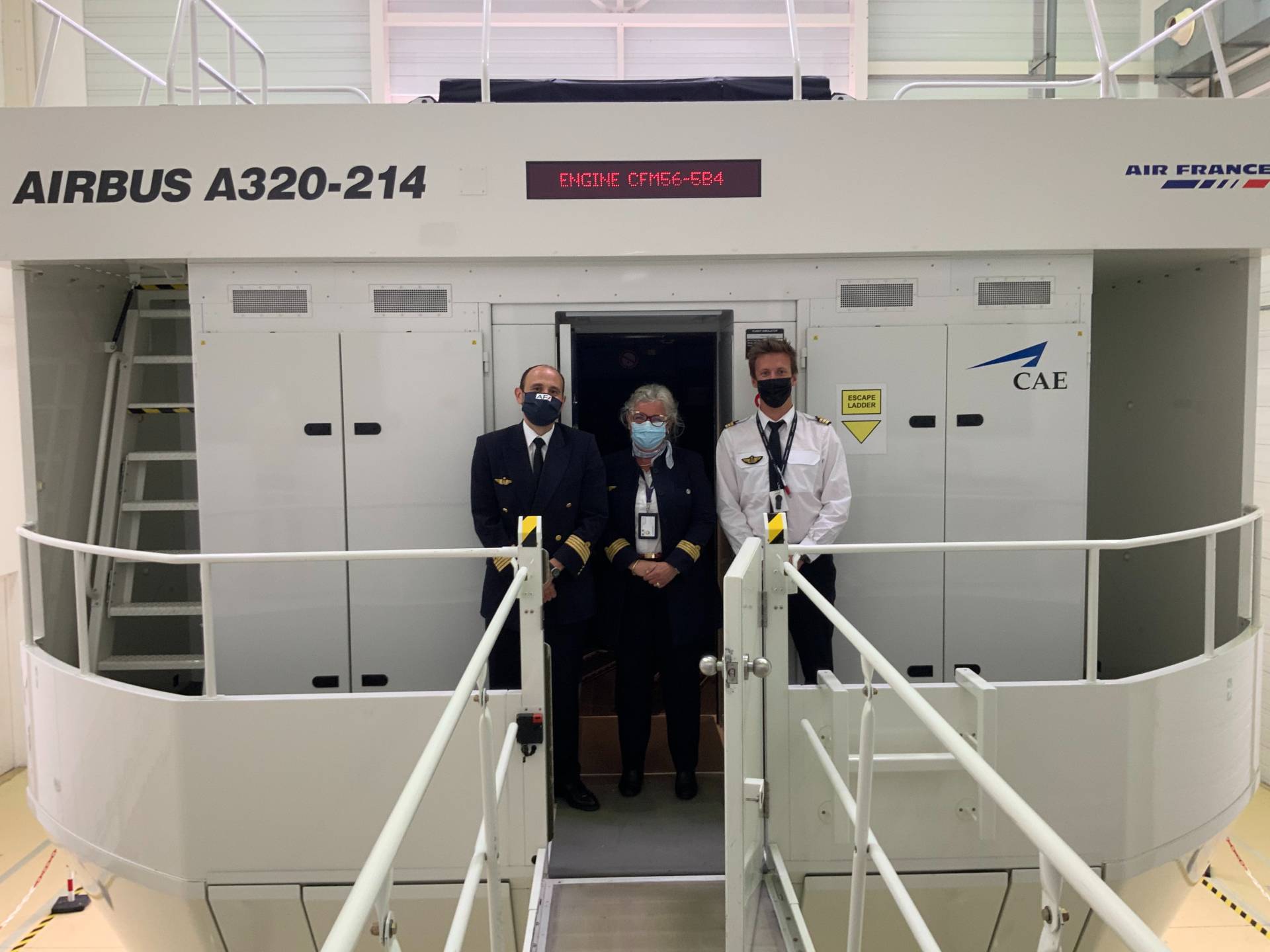Evidence based training что это
Evidence based training что это
На первый взгляд, трудно понять саму концепцию EBT, потому что другие методы подготовки также основаны на фактических данных, так почему же EBT рассматривают именно как новую систему?
Давайте разберёмся, что это такое и с чем его едят.
Основой традиционной системы подготовки являются общие данные по авиации и данные по инцидентам, которые рассматриваются через призму традиционного понимания того, какие манёвры или фазы полёта были критическими для безопасности. На основе этих традиционных заключений авиационные власти составляет список утверждённых упражнений и проверяет пилотов гражданской авиации.
То есть, общая логика здесь понятна.
Например, все знают, что отказ двигателя на скорости V1 (скорость принятия решения на взлёте) может привести к катастрофическим последствиям, это же касается и ухода на второй круг с отказавшим двигателем. В связи с этим, правила требуют, чтобы пилоты по несколько раз отрабатывали эти упражнения во время их подготовки.
Кроме того, статистические данные показывают, что пилоты не способны справляться с отказом двигателя на V1, равно как и уход на второй круг с одним отказавшим двигателем. Это доказывает, что традиционное обучение всегда строилось на фактологической основе.
Но на самом деле это не так. Сегодняшняя реальность такова, что отказы двигателей стали намного более редким явлением, чем раньше. Кроме того современные самолёт способны намного упростить удерживание баланса при отказе одного из двигателей, и управлять воздушным судном в таком случае не так уж и трудно. Даже на ранних моделях Boeing 747-100 отказ двигателя на взлёте уже не был очень опасной проблемой.
EBT предъявляет к пилотам требования, которые основаны непосредственно на операционной среде отдельной авиакомпании, вместо того, чтобы готовить их по общей системе, которая была разработана в 1950-х.
Теперь, имея на вооружении EBT и новую квалификационную систему подготовки, инструкторы обеспечены аналитическим инструментом для определения того, что идёт не так и исправления этого.
Этот инструмент подробно описывает каждый манёвр. И инструктор точно знает где пилот допустил ошибку и почему. Что помогает дать правильные советы и инструкции пилоту.
Например, пилоты ультра-дальних рейсов могут совершать только 1-2 реальных посадок в месяц. Региональные пилоты хорошо знакомы с процедурой визуального захода, а дальне-магистральные пилоты имеют более слабую подготовку в этой сфере.
ИКАО признаёт, что переход к EBT требует изменения в мышлении авиационных властей, инструкторов и экзаменаторов. которые привыкли мыслить шаблонно.
Кроме того, теперь основной упор инструктора должен делаться на выявления «корня» ошибки и её исправления.
ИКАО заявило: «Важно, чтобы только те люди, которые обладают хорошим понимание процесса обучения и могли положительно влиять на поведение человека допускались на должность инструктора».
Это может исключить из списка многих действующих инструкторов, работающих по шаблону.
EBT требует сбора огромного количества информации от конкретных авиакомпаний. Поэтому большинство уважаемых компаний уже сейчас начали сбор необходимых данных. Это поможет составить максимально эффективную программу подготовки.
Посмотрим, как ситуация будет развиваться на практике.
О семинаре «Competence Based Training/Evidence Based Training»
В мероприятии приняли участие более 140 специалистов из государств-участников Соглашения по авиации и использованию воздушного пространства: Республики Армения, Республики Беларусь, Республики Казахстан, Кыргызской Республики, Республики Молдова, Российской Федерации, Республики Таджикистан, Украины и Республики Узбекистан, стран Европы: Великобритании, Испании, Нидерландов, Франции, Турции, а также США и Канады.
· Стандарты и рекомендуемая практика ИКАО в отношении EBT и CBT. Разночтения в русской терминологии CBT/EBT, а также перспективы внедрения рекомендаций ИКАО в подготовке летного состава;
· Внедрение ЕВТ и особенности операционного контекста стран СНГ;
· Внедрение ЕВТ в рамках Европейской нормативной базы и использование данных и технологий для повышения качества подготовки пилотов;
· Особенности подготовки инструкторов и экзаменаторов;
· Оптимизация решений при подготовке пилотов. Процесс всестороннего анализа среды комбинированного авиационного обучения;
· Основные модели и технологии повышения профессиональной готовности пилотов к действиям в нештатных ситуациях с высокой степенью неопределенности и т.д.
Участники семинара познакомились с опытом внедрения EBT в различных авиакомпаниях, особенностями применения методик обучения, перспективами и трудностями перехода на новую систему подготовки персонала и другими аспектами CBT/EBT.
Все презентации, представленные на семинаре CBT/EBT размещены ниже.
Evidence-Based Training
by William Voss
President and CEO | November 27, 2012
In a breakthrough that I would not have expected for years, the International Civil Aviation Organization (ICAO) has approved provisions for evidence-based training (EBT) in ICAO Standards and Recommended Practices. Credit goes to some extraordinary work done by a range of people and organizations that came together faster and better than anyone expected. The Royal Aeronautical Society led a massive working group that included ICAO, the International Air Transport Association (IATA), airlines, manufacturers, regulators and training providers.
For those of you not familiar with EBT, let me emphasize what a big deal this is. I have been a long and vocal critic of training standards around the world. Our training has been trapped in the 1960s and is dangerously out of date. EBT solves that once and for all. It is a process that will allow operators to restructure their training programs to target the real risks in the operation instead of spending all of their training time addressing the threats that existed in the 1960s. It builds on programs like the U.S. advanced qualification program (AQP) and the ICAO advanced training and qualification programme (ATQP).
As the name would suggest, this is a system built on evidence. The industry has pulled together and developed an extraordinary set of baseline data, which will be published by IATA in a document called the Evidence-Based Training Data Report. This report synthesizes information from 3 million flight data records, 9,000-plus line operations safety audit observations, more than 1,000 pilot surveys, and several thousand reports from AQP and ATQP programs. In this baseline, you will find the data you need to overhaul your training program whether you are operating older turboprops or the latest fly-by-wire jets.
The implementation process for EBT will be addressed by guidance material from ICAO and a new Evidence-Based Training Implementation Guide produced jointly by IATA, the International Federation of Airline Pilots’ Associations (IFALPA) and ICAO. Together, these guides will help operators build relevant and effective training programs that start with the baseline data and grow to reflect each operator’s operational data and experience. This type of approach will keep training relevant now and in the future.
As I said, a lot of progress has been made very quickly, but now comes the difficult part. It doesn’t do any good to develop new training strategies if you are not allowed to let go of the old ones. Regulators across the world have to buy in to the approach and will have to develop new ways to oversee training. Evaluating an operator’s training program against a 50-year-old checklist was a pretty simple regulatory task. Evaluating how well an operator builds its program based on operational data will require a regulator that is insightful and sophisticated, and able to devote a lot of time to the task. That may not be a realistic expectation given that many regulators have been decimated by austerity measures or overrun by extraordinary growth.
Government and industry can be proud of the way they have responded to this challenge. I hope that, five years from now, we can be as proud of the way we implemented the changes.
Evidence Based Training: How to improve this concept in regular line operations
Let’s talk together and exchange ideas around the main theme of digitalization in aviation – all points of view are welcome to let things move forward! We need to be reactive to keep the sky safe and give accurate answers to the global pilot shortage!
#EBT #Aviation #PilotTraining #skills #qualification
Evidence-Based Training (EBT) is today on everyone’s lips.
EBT starting point
In Europe, everything started a few year ago with directives from the EASA/IATA and the ICAO:
Also in China the CAAC, in its article 19 / 2019, gives Chinese Airlines a timescale in order to implement EBT.
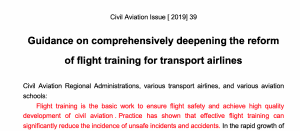
EBT in reality – different approaches
Last year, while visiting different airlines, I have seen several approaches in the way EBT is introduced and applied by various companies.
Especially concerning the implementation of EBT in the simulator, there is a large spectrum in the way it is carried out. This goes from almost full freedom for the instructor in the choice of events / technical problems/airports/weather – often based on a point system, each event having a given number of points depending on the difficulties it will cause to the trainee. Other airlines still apply for a classical predetermined program, without real surprise for the candidate, except for some variations (left or right engine failure for example).
Some airlines also offer instructors the opportunity to access the file of the previous trainee’s qualifications record, in order to know his strengths and weaknesses before going into a simulator session. So a specific program can be performed based on improving the weak points.
These different approaches have their pros and cons but are fine as long as they are conducted in a constructive way!
An excellent way of improving the quality of the training and enhancing pilots’ performances is to confront trainees to the classical startle effect created by some “black swan events”. Such unexpected situations are great experiences for pilots when done in a positive environment and are also a great way to improve their resilience.
After such an unpredictable event, each pilot is in a position to realize what are his strengths and weaknesses.
When realizing his behavior and reactions during such a “black swan event”, it is possible thereafter for the pilot to mainly base his operations on his demonstrated strengths. And by recognizing where his weaknesses are, to be able to, at least, know them and at best develop strategies so that these weaknesses don’t become an obstacle in the overall crew performance.
Open issues of EBT during pilots’ check rides, line training and qualifications
If the implementation of EBT has already well progressed in the simulator, my feeling is that in line operation it is underexploited, usually only applied during the qualification parts, without exploiting today’s possibilities to improve all the potential that EBT gives to the airlines and the trainees.
During discussions I had with several heads of training, I realized that on the qualification’s part there are still some open issues.
The basic criteria of EBT are described in the ICAO document. They are:
Each of these competencies will then be assessed using the so-called behavior indicators linked to the given competencies.
Here are for example the behavior indicators (BI) linked to competency “Leadership and Teamwork”
Extract from: EBT ICAO Manual Doc 9995.en
What are the problems encountered in airlines implementing EBT?
One main point I have heard from some heads of training is that the qualification of trainees becomes somewhat too uniformized (lots of green blocks, meaning rating good to excellent, 3 or 4).
From a pure statistic purpose, in order to see the progress of a fleet, it is still ok. It is easy to show areas where improvement or degradation has happened. But on an individual basis, it makes it more difficult, based only on competencies, to realize which task might be a problem for a given trainee.
For sure, understanding and correcting the trainee about some weaknesses are mainly parts of the debriefing. But for an efficient follow-up, how can a head of training realize a weakness that repeats itself, only by analyzing the result of a competency?
An example given by an instructor, who had no comment possibility on the qualification form, was that he felt it difficult to rate an average good performance at landing (Competency: Aircraft Flight Path Management, manual control), when he experienced during a flights’ rotation 12 perfect landings in fine weather but difficulties in the only one with crosswind! Does he have to rate the performance as excellent knowing there was one exception, or does he have to give an overall bad rating due to the only failure? This is not an easy task for the instructor – and how to forward this important information into the system in order to have an eye on this specific problem?
In my airline, I find our approach convenient: We rate the competencies, then we tag up to 3 behavior indicators linked to this competency and, especially when we have a grading below top level, we have the possibility to make a comment with a written description of the encountered reason justifying such a grading. Thus, we can help the system (Chief Instructor / Fleet Chief) and also the candidate, giving him the most exact “mirror” of his performance.
What about implementing EBT in normal line operations?
In a recent schematic representation, the following components are the foundations of EBT:
These pillars are key elements supporting Evidence Based Training… But how to emphasize them in normal line operations?
These 4 points must be the main focus of an efficient crew-centered debriefing oriented towards EBT. As already mentioned in a previous blog article, nowadays, debriefing is usually only based on pilot’s remembering with all the known weaknesses of human memory, especially in a dynamic situation or a saturating task (such as perception issue problems, bias of the reality, etc.)
This traditional approach can now be massively improved!
Nowadays, most pilots are equipped with a computer or a tablet; the connectivity exists in airports or even in aircraft, and flight data on most modern airplanes is transmitted immediately after landing by wireless QAR. So there is the possibility to use this data in order to better understand, but also to compare the own perception with the reality of facts. A great way to learn about your own limits and situation understanding.
CEFA Aviation proposes a tool that will be of valuable help in order to increase the efficiency of Evidence Based Training, especially for line operations.
DRIVEN BY DATA (4 th pillar)
CEFA AMS is a tool enabling every pilot or instructor to create an animation based on the data from the flight recorder within minutes after landing, in order to use this animation during the debriefing as a solid base for performances’ evaluation and crew centered debriefing.
Using the flight data allows creating animations of specific parts of the flight that are useful for analysis and performances understanding during the debriefing. In the case of different perceptions, a mirror of what really happened can be used to face objective facts and see if the pilot’s perception was correct.
Compared to some tools giving only a statistical approach and some values (for example landing distance, screen height at take-off…), CEFA AMS, in addition to this statistical data, offers the comprehension of the detailed flying process leading to such a value.
DEVELOP THE RESILIENCE (2 nd pillar)
As mentioned in a previous blog article, resilience in normal operations can be enhanced by building up confidence and competencies. Confidence can be increased by allowing a better understanding of performances, especially in a challenging environment (like crosswind landing). Experience can also be improved by sharing knowledge! Animations are today the most used means to share knowledge anyway.
LEARN FROM THE POSITIVE (3 rd pillar)
For the instructor, displaying very positive elements of flight performances allows showing the strengths of a trainee, in order to improve her/his confidence. Learning from positive sequences of own performances is a confidence booster.
During the preflight phase, we also have a potential learning benefit. Why do trainee pilots have to go through the same bad experiences as their predecessors, when it is possible to show them “best practices” in a real-time 3D animation, in order to prepare difficult approaches and minimize mistakes. A detailed analysis of a good performance is an excellent tool for flight preparation.
On the trainees’ side, it brings also the possibility to analyze positive outcomes from the flight performed by the instructor, to see good practice.
Contact us to get a demonstration of this new tool, aimed at pilot training and performance understanding!
Now, what do YOU think about EBT brought to an individual level? Share your personal thoughts in the comments below!
You can also come & discuss with Pierre personally on CEFA Aviation stand, booth #404 during the APATS in Singapore from 3 rd to 4 th September 2019.
Find all the other blog articles gathered here.
You can also contact Pierre via LinkedIn or via this link. Talk to you soon!
Evidence Based Training
Tags
This page provides all the information from EASA to support the implementation of Evidence-Based Training (EBT). The publication of ED Decision 2021/002/R on March 2, 2021 means there is now a lot of work to be done.
3rd EBT Webinar
The 3rd Information Workshop was hosted online from 1330 to 1630 CET on 29th October. The presentations will be availale shortly, in the meantime you can watch the videos of the session below.
The video of Part 1 of the Webinar includes the introductory presentations from EASA and the regulators presentations from DGAC France and AESA Spain.
The video of Part 2 of the Webinar is the Q&A led by the ATPG.
2nd EBT Webinar
The 2nd EBT Information Workshop was hosted online from 1330 to 1630 CET on 29th September. The initial presentations are available at the bottom of the page for download. The video recordings will be posted as quickly as possible.
The video of Part 1 of the Webinar with the presentation from EASA’s experts.
Presentations are available at the bottom for download.
The video of Part 3 with the Q&A and discussion led by the Aircrew Training Policy Group (ATPG).
Check out the content from the 1st Webinar
At the bottom of the page you can download the EASA presentation and notes from the 1st EBT Information Werbinar that was held on 29th June. You can also view the video of the workshop here below.
The key links you might be interested in are:
Register for the 4th Webinar
You can already register for the follow up Webinars that will take place on 29 October and
Airlines achieve first EBT baseline approvals
We want to congratulate Iberia and AirFrance, along with their national authorities AESA Spain and DGAC France, for being the first airlines in the world to receive approval on EBT baseline in accordance with Reg (EU) 2020/2036 and Reg (EU) 2020/2193. For the first time ever, the revalidation of pilot licence are done in accordance to EBT Competences (Appendix 10) instead of the mandatory manoeuvres in appendix 9.
Photo: 1 st Pilot in the world to revalidate in accordance to Appendix 10 Lilia Gómez Rubio (pilot A320), EBT instructor Ignacio Gállego Alemany (EBT manager Iberia), Examiner Miguel Angel Perez Mediano (TRE Iberia and A320 EBT fleet manager), Francisco Javier González Castillo (Head of training), Manuel Angel Samaniego de Tiedra (Deputy head of training and Iberia ATO), Belén García Pozo (Ground Training Manager).
Iberia approved in May 2021. EBT manager Ignacio Gallego Alemany. EASA inspector Amelia Abadía Isla.
Photo: Capt Catherine Urbiha and F/O Jean-Max Vautier during the EBT evaluation.
Air France gained their approval in June 2021. Crew training safety manager Fabien Laignel. DGAC France flight OPS inspector Pascal Foncelle.
For full details about the ED Decision related to EBD you visit the Decision Page on the EASA Website. This decision introduces new flight crew training requirements that are intended to improve pilot competencies by updating the associated acceptable means of compliance (AMC) and guidance material (GM).
This work is part of a global safety initiative endorsed by ICAO that links pilot training to aircraft generation. This is the second step towards the implementation of full EBT. The first step was completed in 2015 with the publication of ED Decision 2015/027/R that provided guidance material to allow the implementation of a ‘mixed EBT’ which maintains the current operator proficiency check (OPC) and licence proficiency check (LPC).
What this recent decision is all about?
This most recent decision completes the second step initiated by allowing authorities to approve the baseline EBT, which replaces OPC and LPC. This means that you can have a single philosophy of recurrent training within your airline. EBT is intended to improve safety by enhancing the capability of flight crews to operate the aircraft in all flight regimes by recognising and managing unexpected situations. The EBT concept is designed to maximise learning and minimise formal checking. Further work is foreseen in the context of the activities of RMT.0599 to allow expansion of EBT to the operator conversion course and initial type rating, as well as to other types of aircraft (e.g. helicopters and business jets).
The impact assessment (IA) detailed in NPA 2018-07 and Opinion No 08/2019 showed that the implementation of EBT by the operator on a voluntary basis is the preferred option in regulating recurrent training and checking of flight crew. The IA illustrates that the adopted rules in combination with the AMC & GM issued with this Decision contribute to significant improvement in safety by strengthening the competencies of flight crews while providing a cost-efficient and socially acceptable framework.





